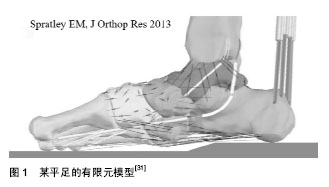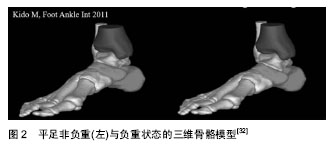| [1] 王正义.足踝外科学[M]. 2版北京:人民卫生出版社,2014:278.[2] Chimenti RL, Tome J, Hillin CD, et al. Adult-acquired flatfoot deformity and age-related differences in foot and ankle kinematics during the single-limb heel-rise test. J Orthop Sports Phys Ther. 2014;44(4):283-290. [3] 包贝西,张建中.足印角及C-S指数与扁平足的相关性研究[J].中国骨与关节杂志,2017,6(6):439-444.[4] Koç A, Karabiyik Ö. MRI evaluation of ligaments and tendons of foot arch in talar dome osteochondral lesions. Acta Radiol. 2018; 59(7):869-875. [5] 施涛.应力位后足冠状位X线片评价儿童柔韧性扁平足的应用研究[D].长沙:湖南师范大学,2017.[6] Blackman AJ, Blevins JJ, Sangeorzan BJ, et al. Cadaveric flatfoot model: ligament attenuation and Achilles tendon overpull. J Orthop Res. 2009;27(12):1547-1554. [7] Saunders SM, Ellis SJ, Demetracopoulos CA, et al. Comparative outcomes between step-cut lengthening calcaneal osteotomy vs traditional evans osteotomy for stage iib adult-acquired flatfoot deformity. Foot Ankle Int. 2018;39(1):18-27. [8] 徐阳,李星辰,彭志杰,等.跟骨Z形截骨治疗柔韧性扁平足[J].中国骨与关节杂志,2016,5(7):530-533.[9] Guha AR, Perera AM. Calcaneal osteotomy in the treatment of adult acquired flatfoot deformity. Foot Ankle Clin. 2012;(2): 247-258. [10] Oka K, Murase T, Moritomo H, et al. Accuracy of corrective osteotomy using a custom-designed device based on a novel computer simulation system. J Orthop Sci. 2011;16(1):85-92. [11] 刘潇,刘耀升,刘蜀彬.有限元法分析腰椎融合与非融合后的应力分布[J].中国组织工程研究,2018,22(3):409-414.[12] 陈亮,桑莉莉,高大伟,等.基于3D打印个性化手术导航模块的微创锥形截骨治疗桡骨上段旋转畸形[J].中华肩肘外科电子杂志,2018,6(2): 151-153.[13] 杜明昌,柳椰,翟良全,等.定制3D打印截骨导板辅助双膝关节同期置换的临床疗效观察[J].中华关节外科杂志(电子版),2018,12(1): 18-23.[14] 钟世镇.数字医学在不同学科中的探索应用[J].中华整形外科杂志, 2018,34(6):前插2.[15] Höhne KH, Pflesser B, Pommert A, et al. A realistic model of human structure from the visible human data. Methods Inf Med. 2001;40(2):83-89. [16] Chung MS, Kim SY. Three-dimensional image and virtual dissection program of the brain made of Korean cadaver. Yonsei Med J. 2000;41(3):299-303. [17] Spitzer VM, Whitlock DG. The visible human dataset: the anatomical platform for human simulation. Anat Rec. 1998;253(2): 49-57. [18] 张绍祥,刘正津,谭立文,等.首例中国数字化可视人体完成[J].第三军医大学学报,2002,24(10):1231-1232.[19] 龚翼星,毛晓芬,杨波,等.数字医学在骨科中的应用进展[J].中华关节外科杂志(电子版),2018,12(2):266-270.[20] 裴国献,张元智.数字骨科学:一门骨科学新分支的萌生[J].中华创伤骨科杂志,2007,9(7):601-604.[21] Peeters K, Schreuer J, Burg F, et al. Alterated talar and navicular bone morphology is associated with pes planus deformity: a CT-scan study. J Orthop Res. 2013;31(2):282-287. [22] Ledoux WR, Rohr ES, Ching RP, et al. Effect of foot shape on the three-dimensional position of foot bones. J Orthop Res. 2006; 24(12):2176-2186. [23] Louie PK, Sangeorzan BJ, Fassbind MJ, et al. Talonavicular joint coverage and bone morphology between different foot types. J Orthop Res. 2014;32(7):958-966. [24] 蔡宇辉,侯曼,郑秀瑗,等.用3维重构技术分析足部骨组织的外翻特性[J].北京师范大学学报(自然科学版),2005,41(5):541-543.[25] Canavese F, Dimeglio A, Bonnel F. Postoperative CT-scan 3D reconstruction of the calcaneus following lateral calcaneal lengthening osteotomy for flatfoot deformity in children. Is the surgical procedure potentially associated with subtalar joint damage. Foot Ankle Surg. 2018;24(5):453-459. [26] Baxter JR, Demetracopoulos CA, Prado MP, et al. Lateral column lengthening corrects hindfoot valgus in a cadaveric flatfoot model. Foot Ankle Int. 2015;36(6):705-709. [27] Niki H, Ching RP, Kiser P, et al. The effect of posterior tibial tendon dysfunction on hindfoot kinematics. Foot Ankle Int. 2001; 22(4):292-300. [28] Prachgosin T, Chong DY, Leelasamran W, et al. Medial longitudinal arch biomechanics evaluation during gait in subjects with flexible flatfoot. Acta Bioeng Biomech. 2015;17(4):121-130. [29] 谢强,王智慧,刘文一,等.三维有限元分析钢板踝关节融合后的力学稳定性[J].中国组织工程研究,2018,22(3):392-397.[30] 张占阅,董乐乐,左强,等.有限元分析法在拇外翻生物力学研究中的应用:可靠性与提升空间[J].中国组织工程研究,2018,22(11): 1762-1767.[31] Spratley EM, Matheis EA, Hayes CW, et al. Validation of a population of patient-specific adult acquired flatfoot deformity models. J Orthop Res. 2013;31(12):1861-1868. [32] Kido M, Ikoma K, Imai K, et al. Load response of the tarsal bones in patients with flatfoot deformity: in vivo 3D study. Foot Ankle Int. 2011;32(11):1017-1022. [33] Yoshioka N, Ikoma K, Kido M, et al. Weight-bearing three- dimensional computed tomography analysis of the forefoot in patients with flatfoot deformity. J Orthop Sci. 2016;21(2):154-158. [34] Xu J, Zhang Y, Muhammad H, et al. In vivo three-dimensional analysis of hindfoot kinematics in stage II PTTD flatfoot. J Orthop Sci. 2015;20(3):488-497. [35] 哈山,许鉴,马昕,等.Ⅱ期成人获得性平足与正常成人足距下关节运动三维测量对比研究[J].国际骨科学杂志,2014,35(4):261-264.[36] Imai K, Ikoma K, Maki M, et al. Features of hindfoot 3D kinetics in flat foot in ankle-joint maximal dorsiflexion and plantarflexion. J Orthop Sci. 2011;16(5):638-643. [37] Chen MJ, Chen CP, Lew HL, et al. Measurement of forefoot varus angle by laser technology in people with flexible flatfoot. Am J Phys Med Rehabil. 2003;82(11):842-846. [38] 苏宏伦,郭俊超,莫中军,等.个性化扁平足矫形鞋垫的生物力学研究[J].医用生物力学,2016,31(6):490-494.[39] Kido M, Ikoma K, Hara Y, et al. Effect of therapeutic insoles on the medial longitudinal arch in patients with flatfoot deformity: a three-dimensional loading computed tomography study. Clin Biomech (Bristol, Avon). 2014;29(10):1095-1098. [40] Bishay SN. Minimally invasive single-session double-level rotational osteotomy of the forearm bones to correct fixed pronation deformity in congenital proximal radioulnar synostosis. J Child Orthop. 2016;10(4):295-300. [41] 徐阳,徐向阳.非胫后肌腱失能性平足诊治进展[J].国际骨科学杂志, 2016,37(2):70-74.[42] 艾福志,李克维.数字骨科技术在寰枢椎手术中的应用寰枢椎脱位系列讲座(七)[J].中国骨科临床与基础研究杂志,2016,8(2):120-127.[43] 张宇航,毕大卫,陈亿民,等.3D打印技术制定个体化截骨角在拇外翻Chevron截骨矫形术中的应用[J].中国骨伤,2018,31(3):203-207.[44] 孙卫东,温建民,胡海威,等.拇外翻第1跖骨颈部不同截骨角度截骨端稳定性有限元分析[J].中华损伤与修复杂志(电子版),2012,7(5): 492-496.[45] Spratley EM, Matheis EA, Hayes CW, et al. A population of patient-specific adult acquired flatfoot deformity models before and after surgery. Ann Biomed Eng. 2014;42(9):1913-1922. [46] 高斌,孙巧巧,杨明,等.3D打印技术辅助儿童复杂性扁平足手术临床应用[J].中国数字医学,2015,10(5):20-22.[47] 南国新.儿童足踝畸形诊治中3D打印技术的应用[J].临床小儿外科杂志,2018,17(4):245-247.[48] 黄志勇,杭飞,靳立军,等.3D打印技术辅助诊断和指导室间隔缺损手术[J].中国医学影像技术,2018,34(7):1099-1103.[49] Ferri M, Scharfenberger AV, Goplen G, et al. Weightbearing CT scan of severe flexible pes planus deformities. Foot Ankle Int. 2008;29(2):199-204. |
.jpg)




.jpg)